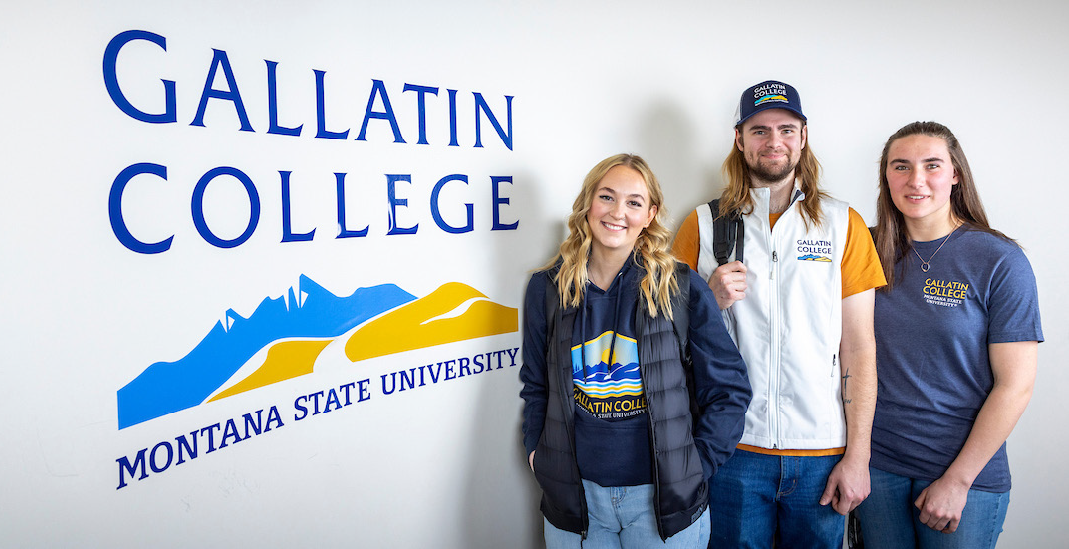A Path to Lifelong Learning that Starts at Home
Nine miles south of Montana’s border with Canada lies Eureka, a small town of about 1,500 people. For 46-year-old Catherine Parker, it’s home. It’s where her two children go to school. It’s where her mineral and jewelry shop is based. And now it’s where new homes and a community aquatic center will go, with help from the business she started after graduating in 2023 from Gallatin College, Montana State University’s two-year college.
Parker earned an associate’s degree in drafting and CAD technology completely online, six hours from Gallatin College MSU’s campus in Bozeman. Uprooting her life and her two children to pursue an education far from Eureka wasn’t an option. When the COVID-19 pandemic struck in 2020 and her shop closed temporarily, she decided it was time to learn a new skill — one that could apply to a variety of fields and had flexible hours.
She learned to create digital models of buildings and machine parts for architects, engineers and manufacturers. After graduating, she launched Parker Drafting and began designing construction plans and 3D models for her community using Revit, a computer program she mastered in college.
“Any kind of education is worth it,” Parker said. “You may not know where it’s going to take you, and it may be different than what you expect, but education is just part of life.”
RURAL ACCESS
According to the US Department of Education in 2023, roughly 35 percent of college students in Montana, like Parker, are enrolled in distance learning programs in some shape or form. Earning a degree remotely is nontraditional, but so are the students taking online classes; they are raising families or working full time while attending college, and are often based in rural areas.
A college degree helps students explore a new passion or gain an advantage in their current industry by increasing their earning potential. That could mean learning to design community centers from remote drafting courses. Or studying ultrasound technology online before training in Montana clinics. Maybe it means using credits from an online associate’s degree to start a four-year program in agricultural business or hospitality management.
The Montana University System, which includes 16 colleges serving more than 40,000 students nationwide, offers 121 fully online programs and 1,608 remote classes. Across MUS universities, about 69 percent of students find a job in Montana and earn at least $42,000 within a year of graduating. Graduates who worked while earning their degree often achieve better employment outcomes than graduates with little work experience, earning as much as $10,000 more than their peers.
While Parker attended online lectures at night, she also ran her shop and took care of her children, who were in elementary and middle school at the time. To accommodate her schedule, Parker took classes at her own pace and completed the program in three years rather than two, graduating in 2023.
From 56 counties, Montanans can explore how to advance their futures and those of their communities.
“Everybody said, ‘Oh, we’ll just mail your diploma so you don’t have to do the drive,’” Parker said. “I thought, ‘No way, I’m walking [in graduation]. I’m so excited about this.’ This degree was totally worth it to me.”
PERSONAL SUPPORT
Montanans earning their degree don’t have to do it alone. MUS colleges provide free academic advising, career coaching and math and writing centers, most of which are offered online. Rachel Johnson, a 28-year-old earning her Associate of Arts degree online from Livingston, has Gallatin College MSU’s writing center bookmarked on her computer.
Not only did she find virtual support in college, but she also drew strength from her professors. When Johnson first started classes, she had trouble balancing her full-time job at a wedding venue and finishing homework in the evening. Johnson emailed her writing professor, and to her surprise, the professor listened to her worries for more than 30 minutes on the phone.
“[One of my professors] would write to us saying, ‘You’re important. You matter, and if you need me, I’m here for you,’” said Johnson, who plans to graduate in May. “It’s nice to see that professors understand.”
For Johnson, the degree could become a stepping stone to a four-year program. Credits from Montana’s two-year colleges are transferrable to universities like MSU, where students can earn a bachelor’s degree in liberal studies fully online as well.
“Each year, Gallatin College MSU offers more online and hybrid opportunities for students across the state,” said Stephanie Gray, dean of the college. “From 56 counties, Montanans can explore how to advance their futures and those of their communities.”

Photo: Adrian Sanchez-Gonzalez, MSU Photo
NEXT STEPS
- To start earning a degree online, fill out an application. Applications are free for Montana residents applying to MUS colleges, which can be found at mus.edu/system.
- Explore opportunities for travel. Hybrid health care programs that help students become
ultrasound technicians, dental hygienists and more are available at
MSU’s two-year colleges through the OneMSU program. - Apply for scholarships. Cat Scholarships are available to students at MSU, while some state scholarships are offered specifically for those attending two-year colleges. The Eric Burtchett Memorial Scholarship Fund’s Trade School Scholarship, for example, is awarded to Montanans completing trade programs in state.
- Once admitted, meet with an academic adviser online to create a personalized course schedule.
To find most MUS two-year colleges and see their degree and online class options, visit applymontana.mus.edu/colleges/choosing-a-college/types-of-colleges/two-year-colleges.html.
Frankie Beer is a writer and editor for MSU Communications.

